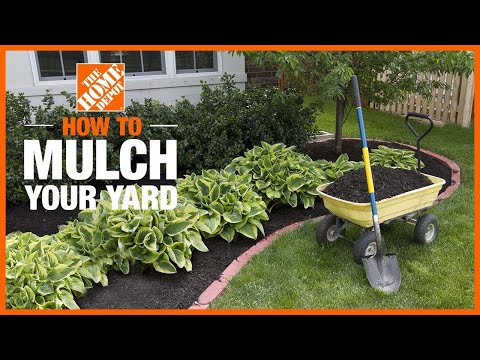Making your own landscape mulch can be both rewarding and practical. It’s a sustainable way to enhance your garden.
Creating mulch at home helps recycle yard waste and enriches your soil. It’s also cost-effective, reducing the need to buy commercial mulch. Plus, you control what goes into it, ensuring no harmful chemicals. Homemade mulch can improve soil health, retain moisture, and suppress weeds.
Whether you have a small garden or a large yard, making your own mulch is a smart move. This guide will walk you through the simple steps to create effective, natural mulch for your landscape. Get ready to transform your yard with homemade mulch!
Introduction To Landscape Mulch
Mulch is a layer of material placed on soil. It helps keep moisture and improves soil health. Mulch can be made from organic or inorganic materials. Many gardeners use mulch to reduce weeds. Mulch also makes gardens look neat and clean.
Mulching helps keep soil warm in winter. It keeps soil cool in summer. Mulch reduces soil erosion. It also helps water stay in the soil. Mulch can add nutrients to the soil. Mulching can make plants grow better and stronger. It makes gardens look nice and tidy.
There are two main types of mulch: organic and inorganic. Organic mulch includes wood chips, straw, and leaves. Inorganic mulch includes rocks, plastic, and rubber. Each type has its own benefits. Organic mulch adds nutrients to the soil. Inorganic mulch lasts longer.

Credit: www.reddit.com
Choosing The Right Materials
Organic mulch comes from natural sources. Examples are wood chips, leaves, and straw. These break down over time and add nutrients to the soil. Inorganic mulch, like rocks or plastic, does not decompose. It lasts longer but does not improve soil health. Organic mulch is better for gardens. Inorganic mulch works well for pathways and decorative areas.
| Material | Type | Best Use |
|---|---|---|
| Wood Chips | Organic | Gardens |
| Leaves | Organic | Flower Beds |
| Straw | Organic | Vegetable Gardens |
| Rocks | Inorganic | Pathways |
| Plastic | Inorganic | Weed Control |
Preparing Your Garden Area
Remove all weeds and old plants. This will keep your garden clean. Pick up sticks and stones. These can harm your new plants. Rake the soil to make it smooth. This helps in planting new seeds. Dispose of all debris in a compost bin or trash.
Test your soil to know its type. You can buy a soil test kit. Add compost if your soil needs nutrients. This helps plants grow well. Mix the compost into the soil with a shovel. Level the soil with a rake. This makes it ready for mulch.
Creating Organic Mulch
Composting is a simple process. You need kitchen scraps and yard waste. Mix these in a compost bin. Keep the pile moist. Turn it often to add air. This helps break down the material. In a few months, you’ll have rich compost. Use it in your garden for healthier plants.
Shredded leaves and wood make great mulch. Use a shredder to chop them up. This creates small pieces. They decompose faster than large pieces. Spread the mulch around plants. It keeps soil moist and cool. It also prevents weeds from growing.
Making Inorganic Mulch
Gravel and stone are good mulch choices. They last long. Choose from many colors and sizes. These are heavy, so they stay in place. They also help with drainage. But be careful. They can heat up in the sun. This might harm plants. Make sure to place a weed barrier first. This helps keep weeds away. Gravel and stone need less upkeep. They are a great choice for dry places.
Rubber mulch is made from old tires. It is very durable. This mulch does not break down. It can last for many years. It is good at keeping weeds away. Rubber mulch also helps with water drainage. It is safe for kids and pets. This mulch comes in many colors. It does not attract bugs. Rubber mulch is also soft. It can protect plants and soil.

Credit: www.youtube.com
Applying Mulch Correctly
The right layer of mulch helps plants grow. Spread mulch about 2 to 4 inches deep. This keeps weeds from growing. Too much mulch can harm plants. It can keep water from reaching roots. Check the depth often. Add more if needed.
Keep mulch away from plant stems. Leave a gap of about 1 to 2 inches. This helps plants breathe. It prevents rot. Mulching too close can trap moisture. This can cause diseases. Watch for signs of trouble. Adjust mulch if needed.
Maintaining Mulched Areas
Check the mulched areas often. Look for weeds or pests. Remove any debris. Keep mulch neat and clean. This helps plants stay healthy.
Add new mulch each year. Mulch breaks down over time. Fresh mulch keeps moisture in the soil. Spread mulch evenly. Make sure mulch is not too deep. Two to three inches is enough.
Cost-effective Tips
Creating your own mulch can save money. Use fallen leaves from your yard. They are free and natural. Grass clippings work well too. Just let them dry first. Old newspapers can be shredded and used. They help keep weeds away. Sawdust from woodwork is another option. Be sure to spread it thin. Too much can harm plants. Pine needles are also good. Collect them from your yard.
Buy materials in bulk to save money. Look for local suppliers. They often have better deals. Ask neighbors for extra yard waste. Share resources to cut costs. Reuse old materials when possible. This reduces waste and saves money. Use cardboard under mulch to stop weeds. It breaks down over time.

Credit: southweststonesupply.com
Frequently Asked Questions
What Is Landscape Mulch?
Landscape mulch is a protective layer spread on soil. It helps retain moisture, suppress weeds, and improve soil health. It also enhances garden aesthetics.
How To Make Mulch At Home?
To make mulch at home, use organic materials. Shred leaves, grass clippings, and wood chips. Spread the mixture evenly on soil.
What Materials Can Be Used For Mulch?
Common materials include wood chips, leaves, grass clippings, and straw. These materials decompose and enrich the soil. Avoid using plants treated with pesticides.
How Often Should Mulch Be Replaced?
Replace mulch annually or bi-annually. Mulch decomposes over time, losing its effectiveness. Regular replacement maintains moisture and prevents weeds.
Conclusion
Creating your own landscape mulch is simple and rewarding. It saves money and reduces waste. Your garden will thrive with nutrient-rich mulch. Plus, homemade mulch improves soil health. Follow these steps and enjoy a healthier garden. Remember, consistency is key.
Regularly refresh your mulch. Your plants will thank you. Happy gardening!

My mission is to help you bring the beauty of nature indoors with expert advice, detailed plant care guides, and creative design ideas.





Leave a Reply